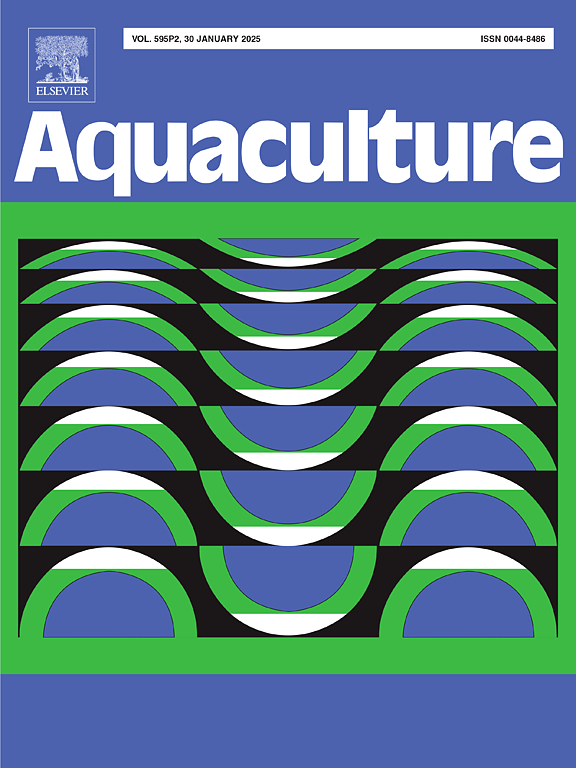适合饲养大鳍礁鱿鱼幼鱼(Sepioteuthis lessoniana)的虾肉食物棒长度
IF 3.9
1区 农林科学
Q1 FISHERIES
引用次数: 0
摘要
大鳍礁鱿鱼(Sepioteuthis lessoniana)是泰国的一种珍贵物种,现在被养殖,具有很大的商业潜力。然而,正确的养殖饲料管理仍然存在争议,特别是在幼鱼阶段和非生命食品项目。本研究采用直径1.5 ~ 2.0 mm不同长度(4、5、6、7、8 mm)的虾肉棒饲喂对虾幼虾,观察其生长、饲料利用、形态计量学、消化酶活性和衣层品质的影响。采用完全随机试验设计,每箱8只10日龄的鱿鱼幼鱼分成三组,连续两周给予完全由凡纳滨对虾(Litopenaeus vannamei)肉制成的食物棒。在饲喂试验结束时,与接受其他长度食物棒的鱿鱼相比,接受4毫米食物棒的鱿鱼(p <;0.05),末重、增重和蛋白质效率显著提高,饲料系数显著降低。喂食5毫米食物棒的鱿鱼与喂食4毫米食物棒的鱿鱼生长相同,但蛋白质利用率较低。较长的食物长度(6,7和8毫米)对鱿鱼有不利影响。4 mm食物棒组的头长、头宽、背套宽度、鳍长、鳍宽等形态计量参数均显著高于对照组,5 mm食物棒组次之。鱿鱼外套膜组织的量热分析表明,摄入较长食物棒的鱿鱼肌肉产生更多的肌凝蛋白和肌动蛋白,有助于肌肉收缩。这些变化与观察到的蛋白水解酶凝乳胰蛋白酶和胰蛋白酶的比活性增加相一致。然而,在所有饮食组中,肌肉组织中的RNA浓度和RNA/蛋白质比率没有差异,尽管接受较长食物棒的鱿鱼的地幔蛋白浓度降低了。上述结果提示,开发长度为4 mm的人工饲料可以提高大鳍礁鱿鱼幼鱼的生长和摄食效率。本文章由计算机程序翻译,如有差异,请以英文原文为准。
Suitable length of shrimp meat food sticks for rearing juvenile bigfin reef squid (Sepioteuthis lessoniana)
The bigfin reef squid (Sepioteuthis lessoniana) is a valued species in Thailand that is now cultivated and has great commercial potential. Nevertheless, the correct feed management for cultivation is still debated, particularly at the juvenile stage and for non-living food items. In the present study, shrimp meat sticks (1.5 to 2.0 mm diameter) of various lengths (4, 5, 6, 7, and 8 mm) were given to juveniles and the effects were observed on growth, feed utilization, morphometrics, digestive enzyme activities, and mantle quality. A completely randomized experimental design was formulated, comprising triplicate groups of 10-day-old juvenile squid (n = 8 per tank) that were given food sticks made solely of whiteleg shrimp (Litopenaeus vannamei) meat for two weeks. At the end of the feeding trial, squid that received 4-mm food sticks, compared with squid that received food sticks of other lengths (p < 0.05), showed significantly higher final body weight, weight gain, and protein efficiency ratio, with a significantly decreased feed conversion ratio. Squids fed 5-mm food sticks grew the same as those fed 4 mm, but their protein efficiency ratio was lower. Longer food lengths (6, 7, and 8 mm) had detrimental effects on squid. The morphometric parameters of head length, head width, dorsal mantle width, fin length, and fin width were significantly higher in squid that received 4-mm food sticks, followed by squid that received 5-mm food sticks. Calorimetric analysis of squid mantle tissue showed that the muscles of squid that ingested longer food sticks developed more myosin and actin, which could assist muscle contraction. These changes were consistent with the observed increased specific activities of the proteolytic enzymes chymotrypsin and trypsin. However, across all dietary groups, there were no differences in RNA concentrations and RNA/protein ratios in muscle tissue, although the mantle protein concentration decreased in squid receiving longer food sticks. These findings imply that developing an artificial feed with a length of 4 mm could enhance the growth and feed efficiency of juvenile bigfin reef squid.
求助全文
通过发布文献求助,成功后即可免费获取论文全文。
去求助
来源期刊

Aquaculture
农林科学-海洋与淡水生物学
CiteScore
8.60
自引率
17.80%
发文量
1246
审稿时长
56 days
期刊介绍:
Aquaculture is an international journal for the exploration, improvement and management of all freshwater and marine food resources. It publishes novel and innovative research of world-wide interest on farming of aquatic organisms, which includes finfish, mollusks, crustaceans and aquatic plants for human consumption. Research on ornamentals is not a focus of the Journal. Aquaculture only publishes papers with a clear relevance to improving aquaculture practices or a potential application.
 求助内容:
求助内容: 应助结果提醒方式:
应助结果提醒方式:


